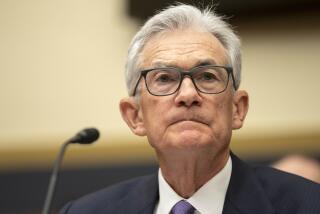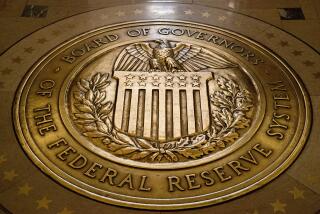Fed leaves interest rates unchanged amid concerns about low inflation
The Federal Reserve left interest rates unchanged Wednesday and conveyed a tad more concern about recent inflation trends, clouding the prospects for when the next rate hike might come.
At the same time, the central bank said after its two-day meeting that U.S. economic conditions looked good, with job growth solid and consumer and business spending continuing to expand.
And the Fed gave further signals that it was close to paring down the $4.5 trillion in U.S. Treasury and mortgage-backed securities it accumulated during and after the financial crisis in 2008.
A shrinking of those assets, like raising interest rates, is aimed at normalizing monetary policy and removing the extraordinary support the Fed has provided to the economy over the past decade.
Analysts think the Fed will launch that process at its next meeting Sept. 19-20, an expectation reinforced by Wednesday’s statement that it would begin shedding the holdings “relatively soon,” as opposed to its prior guidance that it would happen “this year.”
“A start date for the balance sheet normalization is all teed up for the September meeting,” said Greg McBride, chief financial analyst at Bankrate.com, a research firm.
A reduction of Fed assets is expected to nudge up mortgage and interest rates, but policymakers are planning to act gradually and in a predictable manner, increasing the amount of maturing securities it will unload each month, with the whole process expected to take a few years.
Of greater short-term uncertainty is when the Fed will make its next interest rate hike.
Policymakers have taken measured steps to raise interest rates in each of the last three quarters, after years of keeping them at rock bottom levels to stimulate the economy.
By the Fed’s latest forecast in June, another quarter-point rate increase should come before the year is up. The Fed’s benchmark overnight rate is now between 1% and 1.25%.
But inflation has eased in the last three months, slipping further below the Fed’s 2% target, even though job growth has been strong. Typically, a tightening labor market should be pushing up wages and inflation.
Fed Chairwoman Janet L. Yellen has regarded the recent softening in inflation as mostly a blip due to special factors like cuts in cellphone plans.
In June, when the Fed last lifted its federal funds rate, officials acknowledged that inflation was running “somewhat below” their 2% goal. At that meeting, there was one dissent to raising the rate among the nine voting members.
Wednesday’s statement, which was approved unanimously, erased the word “somewhat,” and reiterated that policymakers will be carefully watching actual and expected inflation measures. The statement, as before, also said that the Fed expects inflation to stabilize around the 2% figure over the medium term.
Economists are not sure why inflation has lagged. While a little inflation can help boost wages and company profits, inflation that is too low and dropping can be trouble. Among other things, it raises the risk of outright falling prices, or deflation, which can dampen spending and growth.
At this point, relatively few economists seem to be worried that the recent inflation trend is signaling problems ahead.
The economy this month entered its ninth year of expansion, already the third longest such stretch in the U.S. history. But compared with past expansions, economic growth has been slow throughout, at an annual pace averaging about 2%. This year is also looking to come in around that pace.
On Friday, the government is expected to report that growth in the nation’s gross domestic product, or economic output, picked up to an annual rate of around 2.5% in the second quarter, after a lackluster 1.4% performance in the first three months of the year.
“I would be concerned if inflation weakened because the job market hit a wall and wage growth began to stall,” said Mark Zandi, chief economist at Moody’s Analytics, a forecasting firm. “I might also be concerned if inflation was soft due to a strengthening in the value of the U.S. dollar due a struggling global economy.”
But neither of those things are happening. While wages have not taken off as hoped, they are still increasing at an annual rate of about 2.5%, which is a little better than most prior years of the recovery.
Job growth, meanwhile, has outperformed the moderately advancing economy, indicating that there may be a bigger supply of willing and able workers on the sidelines than thought.
As for the global economy, the outlook has brightened in recent months as growth in the Eurozone has improved while China and some other major developing economies are chugging along.
“I don’t think the soft inflation readings reflect a weakening economy,” Zandi said. “They largely reflect a confluence of measurement issues and one-off factors.”
Still, economists don’t expect to see the next interest rate hike until the Fed’s last meeting of the year in December, at the earliest.
“That will have to wait until December, most likely, and some firming of inflation will be needed in the coming months in order for that to happen,” said Curt Long, chief economist at the National Assn. of Federally-Insured Credit Unions.
The Fed’s meeting this week was the fifth of eight scheduled for this year and did not include a news conference with Yellen, whose term as chair expires early next year.
She said during a congressional hearing earlier this month that she fully intended to complete her term but declined to say whether she would serve another four years if renominated by President Trump.
Trump told the Wall Street Journal this week that he is considering another term for Yellen and that Gary Cohn, his director of the National Economic Council, is also a top candidate.
ALSO
Amazon announces U.S. hiring spree as labor market tightens
Home prices in parts of Southern California are at record highs — and keep rising
UPDATES:
2:05 p.m.: This article was updated with staff reporting.
This article was originally published at 11 a.m.







